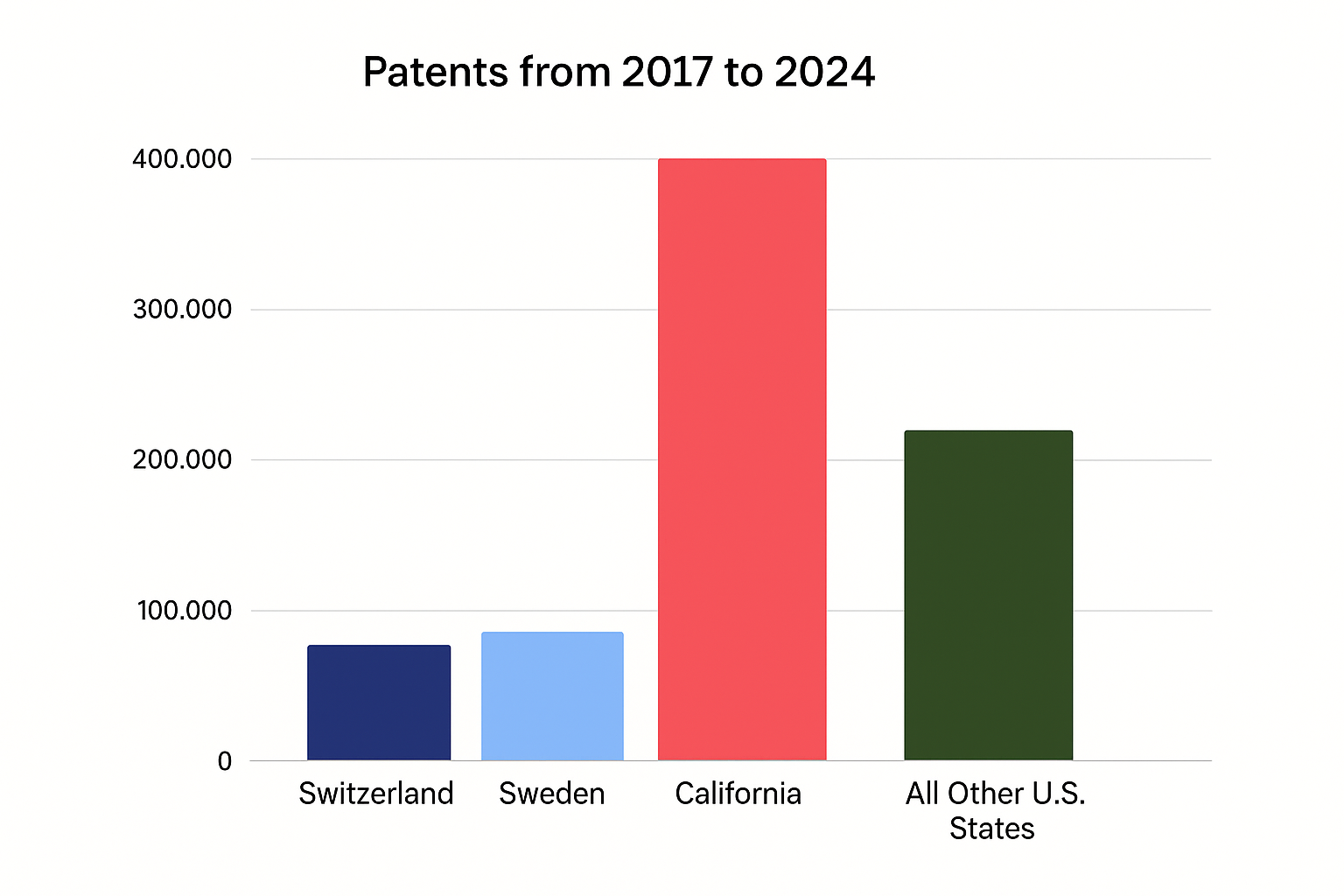When the World Ranks Innovation, America Slips—But Santa Cruz Holds a Torch
The arrows and numbers in this type of Global Innovation Index chart usually indicate changes in rank compared to the previous year
The Germans once defined modern invention.
Printing presses, cars, gummy bears—you could fill a cultural museum with their breakthroughs. But in the latest Economist-highlighted Global Innovation Index, Germany tumbles out of the world’s top ten. The story gets worse for the U.S., which, though still ranked third, is showing cracks. Instead, it’s tiny Switzerland and Sweden that set the global pace. The Economist: The World’s Most Innovative Countries
Switzerland, with just under 9 million people, tops the list again. Its weapon? Precision—small, tightly networked universities and companies spinning out patents like clockwork. Sweden, with fewer than 11 million citizens, leverages its social infrastructure and engineering base to land second. The United States, sprawling, diverse, and still formidable, sits at number three, with worries that political whiplash and narrowed venture bets (AI over everything else) might dull its edge. China muscled into the top ten, confounding the critics who once dismissed it as a “fat tech dragon.”
California
When global reports talk about “U.S. innovation,” they lump together a continent-sized economy of 330 million people. But if you carve out California alone, the picture changes dramatically. Between 2017 and 2024, inventors in California filed roughly 419,000 patents with the USPTO—more than many entire nations combined. By itself, California would rank among the top innovation powerhouses in the world, rivaling or surpassing mid-sized leaders like Switzerland and Sweden, despite their impressive per-capita showings.
Switzerland still reigns as the per-capita champion, with more than a thousand patents per million residents each year and a dense network of research institutions driving efficiency. Sweden, likewise, leverages its population of just over ten million to consistently land near the top of the Global Innovation Index. California, with 39 million residents and an economy recently ranked as the fourth largest in the world, generates a volume of innovation that dwarfs its European peers. What Switzerland and Sweden achieve through concentration, California achieves through scale, making the Golden State a critical engine not just of U.S. innovation, but of global technological progress.
Santa Cruz
But if you zoom from the macro to the micro, something fascinating happens. National rankings often miss the bright, localized nodes where innovation actually happens. One of those nodes is a county that usually makes headlines for surfing contests and redwood hikes: Santa Cruz, California.
Innovation events this month
Oct 20: Cracking the Code
Oct 28: Genomics Rooftop Mixer
Santa Cruz County’s contribution to the national patent ledger may be modest in raw numbers—new applications dropped off after 2020, hovering in the single digits monthly. But what those statistics obscure is the intensity of what’s brewing there. Take Joby Aviation, the electric vertical take-off and landing (“EVTOL”) company headquartered in Santa Cruz. What began as a scrappy experiment in sustainable flight has blossomed into a publicly traded company redefining air mobility. Each test flight out of Marina Municipal Airport represents not just engineering prowess, but a reimagining of how cities might breathe without the choke of traffic.
Or look at Philippe Kahn. If you don’t know the name, you certainly know his work. He invented the first camera phone—snapping a baby photo in a hospital room and forever altering how we capture life. Kahn has since stacked up well over 200 patents, with numbers north of 300 depending on who’s counting. Today, through Fullpower-AI, he’s extending Santa Cruz innovation into wearables and sleep science, blending hardware, software, and AI in ways that rival anything in Silicon Valley proper.
And then there’s the University of California, Santa Cruz. Beyond its postcard campus with ocean views, UCSC is quietly shaping the future of genomics and biotech. The university manages more than 300 active patents and issued 26 new ones in fiscal 2023 alone. Baskin School of Engineering churns out patents in nanopore sequencing, LEDs, and more. This is the same institution that helped assemble the Human Genome Project, and it’s still at it—this time with long-read sequencing, computational genomics, and even “genomic time travel” to understand how kelp adapts to climate change.
Santa Cruz’s innovation footprint won’t close the gap that national rankings fret over. But it illustrates why such lists can mislead. Global indexes tally countries. Innovation thrives in places—ecosystems where inventors like Kahn, companies like Joby, and researchers at UCSC create outsized impact.
If you want a front-row seat to that future, you don’t need to book a flight to Zurich or Stockholm. On October 28, Santa Cruz Works and UCSC scientists will showcase their latest research at the Genomics Rooftop Mixer, where cancer diagnostics, AI-driven health platforms, and kelp genomics will take center stage. It’s Santa Cruz’s chance to prove that even in a world of shifting innovation hierarchies, the local spark still matters—and sometimes, it changes everything.
You Might Also be Interested…
The difference between iteration and true innovation by Guy Kawasaki



